*NURSING > ESSAY > Fundamental of Nursing II : Fluid, Electrolyte, and Acid–Base Balance ESSAY | Already GRADED A. (All)
Fundamental of Nursing II : Fluid, Electrolyte, and Acid–Base Balance ESSAY | Already GRADED A.
Document Content and Description Below
Fundamental of Nursing II : Fluid, Electrolyte, and Acid–Base Balance Prepared by: Mahdia Samaha Kony 2021 Second semester 1 INTRODUCTION • In good health, a delicate balance of fluids, el... ectrolytes, acids, and bases maintains the body. • This balance, or homeostasis, depends on multiple physiological processes that regulate fluid intake and output, as well as the movement of water and the substances dissolved in it between body compartments. 2 Body Fluids • Fluid means water that contains dissolved or suspended substances such as glucose, mineral salts, and proteins. • Water normally accounts for 50% to 70% of the body’s total weight and serves as the liquid in which the body’s solid components are dissolved. Age affects the percentage of water that comprises total body weight. For example: • Adult males: 60% to 65% • Adult females: 55% to 60% • Older adults: 50% to 55% • Children: 50% to 55% • Full-term infants: 65% to 70% • Premature infants: 65% to 80% • Within the body, the lungs are composed of approximately 90% water 3 while the brain is 70% water. Each individual’s blood is 80% to 83% water Distribution of Body Fluids • Intracellular fluid (ICF) is found within the cells of the body. It constitutes approximately two-thirds of the total body fluid in adults. • Extracellular fluid (ECF) is found outside the cells and accounts for about one-third of total body fluid. It is subdivided into compartments. The two main compartments of ECF are: 1. Interstitial: Fluid in the spaces between body cells; about 22 % 2. Intravascular: Fluid within blood vessels (plasma); about 6%. 3. Transcellular: Specific fluids, such as lymph, cerebrospinal, peritoneal, synovial, pleural, intraocular, biliary, and pancreatic; about 2 %. 4 Movement of Body Fluids and Electrolytes • Even though fluids are distributed within the interstitial space and the intravascular space, they are never static. • Fluids are continually moving across membranes to other compartments in an effort to maintain equilibrium between the compartments. • Small particles such as ions, oxygen, and carbon dioxide move easily across a semipermeable membrane that has the character of selective permeability, but larger molecules such as glucose and proteins have more difficulty moving between fluid compartments. • Solutes may be crystalloids (salts that dissolve readily into true solutions) or colloids (substances such as large protein molecules that do not readily dissolve into true solutions). • A solvent is the component of a solution that can dissolve a solute 5 Movement of Body Fluids and Electrolytes • Diffusion: • Passive process whereby molecules move across a membrane from a more concentrated solution to a less concentrated solution. • For example: Oxygen moves from the alveoli into the pulmonary capillaries and carbon dioxide moves from the pulmonary capillaries into the alveoli. 6 Movement of Body Fluids and Electrolytes • Osmosis is the movement of water across cell membranes, from the less concentrated solution to the more concentrated solution. • In other words, water moves toward the higher concentration of solute in an attempt to equalize the concentrations. 7 • The concentration of solutes in body fluids is usually expressed as the osmolality. • Sodium is the greatest determinant of the osmolality of plasma • Potassium, glucose, and urea are the primary determinants of the osmolality of intracellular fluid. • Osmotic pressure is the power of a solution to pull water across a semipermeable membrane. • Mannitol: An Osmotic Diuretic which increases the osmolality of the blood so that water will be pulled from the interstitial spaces into the intravascular space, where it can then be eliminated by the kidneys and is administered for patient with increased intracranial 8 pressure, which, if poorly controlled, can result in brain damage. Movement of Body Fluids and Electrolytes • Filtration: Passive process whereby fluid and smaller molecules move from an area of higher pressure to an area of lower pressure. • Hydrostatic pressure is the pressure exerted by a fluid within a closed system on the walls of th container in which it is contained. • The hydrostatic pressure of blood is the force exerted by blood against blood vessel walls. Example; heart failure 9 Active transportation • Active process whereby metabolic energy moves substances across a membrane from a less concentrated solution to a more concentrated solution • For example: The sodium- potassium pump moves sodium out of cells and potassium into cells. 10 Regulating Body Fluids • FLUID INTAKE • During periods of normal activity at moderate temperature, the average adult drinks about 1,500 mL/day, despite the fact that they need 2,500 mL/day for normal functioning. • The thirst mechanism is the primary regulator of fluid intake. Stimuli that trigger the thirst center: • osmotic pressure of body fluids • vascular volume • angiotensin (a hormone released in response to decreased blood flow to the kidneys) • causing the sensation of thirst and the desire to drink fluids. 11 Abnormal Movement of Fluids • When, the body is unable to maintain fluid and electrolyte balance, normal fluid-moving processes are impaired. • Third-spacing of fluids, meaning the fluids are shifted to areas where they can no longer contribute to fluid and electrolyte balance between ICF and ECF. • This third-spacing of fluid results in edema and ascites, a large collection of fluid within the peritoneal cavity. The effects of third-spacing include the following: • Lowering the volume of the blood, thereby lowering the blood pressure • Increasing the volume of fluid in the interstitial spaces, thereby possibly causing excessive edema, which can result in compression of nerve endings, capillaries, and cells • Lowering the solute concentration of the interstitial fluid, thereby causing excessive amounts of water to move into the cells, resulting in over hydration and possible rupture of the cells, better known as cellular death. 12 Water functions • A medium for metabolic reactions within cells • A transporter for nutrients, waste products, and other substances • A lubricant • An insulator and shock absorber • A means of regulating and maintaining body temperature. 13 Regulation of Body Fluids Fluid intake Fluid output 14 Maintenance of Fluid Balance The kidneys are the primary regulator of the body fluid and electrolytes. Normally the kidneys filter 135 to 180 L of plasma daily in the adult, while excreting only 1.5 L of urine; selectively retain electrolytes and water and excrete wastes and excesses. Antidiuretic hormone (ADH). • ADH causes the kidneys to retain fluid • Pressure sensors in the vascular system stimulate or inhibit the release of ADH. 15 • Renin-angiotensin-aldosterone system • Decreased blood flow or decreased blood pressure stimulates the release of renin from the kidneys. • Renin stimulates the conversion of angiotensin I to angiotensin II. • Angiotensin II acts on the kidneys to retain sodium and water and stimulates the adrenal cortex to release aldosterone. • Aldosterone stimulates the kidneys to reabsorb sodium and excrete potassium. • Atrial natriuretic peptide (ANP). • Atrial stretching in the heart stimulates release of ANP. • ANP acts as a diuretic by increasing sodium excretion and inhibiting the thirst mechanism. 16 Alterations in Fluid Balance • Fluid Volume Deficit (FVD) • Hypovolemia: Loss of both fluid and electrolytes in equal or isotonic proportions. • Dehydration: Loss of fluid without a significant loss of electrolytes, resulting in a hyperosmolar imbalance. Causes a. Decreased fluid intake. b. Loss of plasma or blood. c. GI losses by vomiting, diarrhea. d. Sweating. e. Adrenal insufficiency. f. Excessive urination (polyuria) 17 Clinical manifestations. • Hypotension, orthostatic hypotension. • Weak, thready, rapid pulse. • Flat neck veins. • Decreased capillary refill. • Atonic muscles. • Lethargy. • Mental confusion. • Sunken eyeballs. • Thirst. • Decreased urine output (oliguria, anuria). • Flushed, dry skin and mucous membranes. • Decreased tissue turgor; ( prolonged tenting) • Hemoconcentration results in increased hematocrit (>50%), blood urea nitrogen (>21 mg/dL), and urine specific gravity (>1.029). 18 Dehydration (hyperosmolar imbalance): Occurs when water is lost from the body leaving the client with excess sodium. The serum osmolality & serum sodium increased. Water is drawn from the interstitial space and the intracellular compartment into the vascular compartment leaving the cells dehydrated. Risk factors: • Older pt. due to decrease thirst sensation • Hyperventilated pt. • Prolonged fever. • Diabetic ketoacidosis. • Pt. with enteral feeding & insufficient fluid intake 19 B. Fluid Volume Excess (FVE) Hypervolemia: • Excessive amount of fluid and sodium in isotonic proportions. Causes. a. Excessive sodium intake b. Excessive IV fluids (NacL). c. Congestive heart failure. d. Kidney disease. e. Increased aldosterone. f. Increased ADH. Clinical manifestations. • Pitting edema: Edema does not become evident until the interstitial fluid volume has been increased by 2.5 to 3 L. 20 Clinical manifestations. • Crackles on auscultation of the lungs. • Hypertension. • Rapid pulse. • Distended neck veins. • Muscle weakness, fatigue. • Mental confusion. • Diluted urine, possibly with increased volume. • Hemodilution results in decreased hematocrit (<40%) and blood urea nitrogen (<8 mg/dL). 21 Nursing Care for Patients With Fluid Imbalances Commonalities of nursing care for patients with a fluid imbalance. a. Obtain a health history to identify possible causes. b. Obtain vital signs. c. Assess breath sounds; be aware that crackles and dyspnea indicate possible fluid overload. d. Assess mucous membranes, presence of thirst, and skin turgor; determine the extent of edema or presence of tenting. 22 Obtain a daily weight. (1) Use the same scale every time; use a standing, chair, or bed scale, depending on the patient’s condition. (2) Weigh the patient at same time every day, such as before breakfast after the first voiding. (3) Weigh the patient each day wearing similar clothes or use similar linens when using a bed scale. • An acute loss of 0.5 kg represents a fluid loss of approximately 500 mL. (One liter of fluid weighs approximately 1 kg.) 23 Nursing Care for Patients With Fluid Imbalances Monitor intake and output (I&O). • I&O for patients who are unstable, critically ill, or febrile; are receiving diuretics, continuous or intermittent IV infusions, or tube feedings; have had a procedure; or have fluid restrictions because of conditions such as FVD, FVE, or heart or kidney failure. • Measure all fluid that goes into the body, such as oral, IV, tube feedings, and instillations into the GI tract or urinary bladder. • Measure all fluid that exits from the body, such as urine, liquid feces, vomitus, wound drainage, and fluid from gastric decompression; and identify characteristics of output (e.g., color, clarity, and odor). 24 • Use standard precautions when collecting certain body fluids; • Measure volume in milliliters with an accurate measuring device. • Record solid food that becomes a liquid at room temperature, such as ice cream and gelatin, in its entire volume. • Record ice chips at half their volume • Document immediately after administration or collection of fluid at the appropriate time on the I&O record. • Teach the patient and family about monitoring fluid intake and output; encourage self-monitoring of I&O if the patient is capable. 25 Nursing Care for Patients With FVE • Assess level of consciousness, energy level, and changes in behavior. • Monitor laboratory results, such as hematocrit, blood urea nitrogen, serum electrolytes, creatinine clearance, and urine specific gravity. • Change position and massage dependent areas every 2 hours to prevent pressure ulcers. • Facilitate oral fluid intake or restriction: • Allow one-half during the day • two-thirds of the remaining fluid in the evening • the rest during the night. 26 Specific nursing care for patients with fluid volume excess (FVE). • Assess the extent of third spacing ( Intestinal fluid) by measuring with a centimeter tape over the umbilicus for abdominal girth associated with ascites and circumference of extremity associated with peripheral edema or compartment syndrome (mark the site on the extremity for continuity of assessments). • Maintain the patient in a mid- or high-Fowler position to promote respirations. 27 Specific nursing care for patients with fluid volume excess (FVE). • Facilitate ordered fluid restriction. • Offer fluids between rather than with meals. • Offer ice chips to relieve thirst; liquid volume is half frozen volume. • Use a small container to promote perception of a larger volume when providing fluids. • Suggest chewing sugarless gum to help keep the oral cavity moist. 28 Management: • Dietary restriction of sodium • Diuretics to reduce edema by inhibiting the reabsorption of sodium and water by the kidneys. • Hemodialysis: When renal function is so severely impaired that pharmacologic agents cannot act efficiently, other modalities are considered to remove sodium and fluid from the body 29 Specific nursing care for patients with fluid volume deficit (FVD). a. Administer IV fluids as ordered. b. Use an intravenous controller device. c. Provide frequent mouth care. d. Use assistive devices, to protect the skin over bony prominences. e. Facilitate ordered oral fluid intake (oral rehydration therapy): (1) Set short-term goals. (2) Offer preferred fluids. (3) Serve fluids at appropriate temperatures, such as cold beverages and hot tea and coffee. (4) Encourage intake of foods that become liquid at room temperature, such as ice ream and custard. 30 Administration of IV Solutions • A solution that has about the same concentration of particles, or osmolarity, as plasma (between 275 and 295 mOsm/L) is considered an isotonic solution. • Hypertonic solution has a greater osmolarity than plasma (295 mOsm/L). Because a hypertonic solution has a greater osmolarity, water moves out of the cells and is drawn into the intravascular compartment, causing the cells to shrink. • A hypotonic solution has less osmolarity than plasma (275 mOsm/L). Because of a lower osmolarity, a hypotonic solution in the intravascular space moves out of the intravascular space and into intracellular fluid, causing cells to swell and possibly burst. 31 32 33 Uses of IV fluids • Isotonic fluids; are used to replace extracellular volume (e.g., prolonged vomiting). • Hypotonic solutions ; are used most often to hydrate cells (e.g., hypertonic dehydration, required water replacement). • Hypertonic solutions ; are used most often to increase extracellular fluid volume (e.g., replace electrolytes, treat shock). 34 Types of Solutes: • Crystalloids ( salts that dissolve readily into true solutions) • Colloids (substances such as large protein molecules that do not readily dissolve into true solutions). • Administer all IV fluids carefully; • isotonic solutions could cause increased fluid overload in patients with renal or cardiac disease; • hypotonic solutions could cause a hypotensive state in a patient with low blood pressure • hypertonic solutions are irritating to the vein and have the potential to cause increased risk of heart failure and pulmonary edema. 35 Venipuncture ; • Purposes: • To collect blood spicemen • Start an Iv infusion • Provide vascular access for later use • Instill medication • Inject radioopaque 36 Contraindicated sites: • Sites that has a signs of infection, infiltration, thrombosis • An extremity with dialysis access • A site of mastectomy • Avoid areas of flexion • Choose the most distal appropriate site. • Using a distal site first allows for the use of proximal sites later if the patient needs a venipuncture site change. 37 38 Changing IV fluid containers, tubing, dressing: ➢ Continuous infusion tube to be changed every 96 hours unless it is contaminated ➢ Intermittent infusion tube to be changed every 24 hours because of the risk of contamination ➢ Blood or blood components tube to be changed every 4hours ➢ IV tube for continuous lipids every 24hrs ➢ Gauze dressing to be changed every 48hrs. Complications of IV Therapy and Related :Nursing Care Fluid Overload • Excessive fluid within the intravascular compartment. Causes • Fluid is infused too rapidly. • Excess amount of fluid is infused. • IV volume overwhelms patient’s status. Clinical Manifestations: • Weight gain. • Edema. • Distended neck veins. • Hypertension. • Tachycardia. • Shortness of breath. 40 Prevention • Use an infusion device to regulate the flow rate. • Monitor the patient and infusion frequently (e.g., every 30 to 60 minutes). Intervention • Decrease the flow rate of the infusion to keep the vein open while awaiting medical orders. • Place the patient in the high- Fowler position. • Obtain and monitor the vital signs. • Administer oxygen. • Document the patient’s status and notify the primary healthcare provider. 41 Infiltration & Extravasation • IV fluid accidentally leaks into the interstitial compartment. Causes • IV catheter tip is displaced outside of the vein. Clinical Manifestations: • Decreased flow rate. • Cessation of flow. • Coolness, pallor, swelling, and tenderness at site. Prevention • Secure the catheter to limit movement in the vein. • Instruct the patient to minimize flexion of the involved extremity. 42 Intervention • Stop the infusion immediately. • Remove the catheter and restart one at another site. • Follow agency protocol (e.g., elevate involved extremity on a pillow, apply cool or warm compresses). • Document the patient’s status and notify the primary healthcare provider immediately. • Document the event. 43 Phlebitis • Inflammation of a vein. Causes • Mechanical irritation. • Caustic solution, such as potassium chloride, antibiotics, and vitamin C. • Infection Clinical Manifestations: • Redness, warmth, swelling, and pain at site. • Decreased flow rate. • Palpable erythematous cord along vein. 44 Prevention • Secure the catheter to limit movement in the vein. • Rotate the site every 72 hours. Intervention • Remove the catheter and restart one at another site. • Elevate the affected arm on a pillow. • Follow agency protocol (e.g., apply cold compress initially, apply warm compress every 4 to 6 hours for 20 minutes). • Document patient’s status and notify the primary health-care provider if erythema or streaking is present. 45 46 Blo d transfusion • Objective of administration; 1. Increasing circulatory volume after surgery, trauma, bleeding 2. Increasing RBCs in case of anemia 3. Replacement therapy; clotting factors, platelets, albumin 47 Transfusion of Blood and Blood Products • Infusion of whole blood • Infusion of a blood component such as: 1. Plasma 2. Red blood cells( BBCs) 3. Platelets. A blood transfusion is given into the patient’s venous circulation. Recipient: The person receiving the blood Donor: The person giving the blood is the 48 • The donated blood is stored at 1° to 6°C for 35 to 42 days • Various anticoagulants and preservatives are used to maintain the shelf life of donated blood. • Types f Blood Preservatives : 1. Citrate-phosphate-dextrose (CPD) 2. Citratep hosphate- dextrose-adenine (CPDA-1) • When blood is stored, there is continual destruction of red blood cells, which releases potassium (K) from the cells into the plasma. 49 ABO SYSTEM • The ABO system uses the presence or absence of specific antigens on the surface of red blood cells to identify blood groups. • Four main groups (A, B, AB, and O) • The surface of an individual’s red blood cells contains a number antigens that are unique for each person. • The plasma contains antibodies against specific RBC antigen. 50 Blood Groups • Individuals with blood group A have A antigen on their RBCs and anti-B antibody in their plasma. • Individuals with blood group B have B antigen on their RBCs and anti-A antibody in their plasma • Individuals with blood group AB have A and B antigens on their RBC surface in people with group AB blood and no antibodies against either antigen in the plasma. • Neither antigen is present in people with group O blood but has both anti-A and anti-B antibodies in the plasma. 51 RH SYSTEM • Rh antigen may be present on the surface of red blood cells • The type D antigen is widely prevalent and is most likely to elicit an immune response • A person with the D antigen is Rh positive, and a person without the D antigen is Rh negative • A person with Rh-negative blood must first be exposed to Rh positive blood before any Rh antibodies are formed. • These antibodies take up to 2 weeks to form. • A person with Rh-negative blood who is exposed to a large volume (200 mL or more) of Rh-positive blood will develop enough antibodies to cause a severe transfusion reaction with repeat exposure. 53 Precautions when administering blood; • Use large gauge catheter • Use tube with filter • Prime the tube with 0.9 NaCl • Initiate transfusion slowlyInitial flow rate during this time should be 2mL/min or 20 gtt/min. • Stay beside the pt 15 min after starting • Whole blood and packed cells to be given in 2 hours. Or in 4 hours when there is risk of ECV exccess 54 • > 4hours there is risk of infection Safety Guidelines 1- Administration of blood and blood components requires meticulous attention to detail (e.g., preparation, administration, and monitoring) to prevent life-threatening transfusion reactions 2- Ensure that each blood unit is correctly labeled; check against patient’s identification. 3- Review agency policy and procedure regarding administration of blood or blood products. 4 - Two nurses should verify correct unit and correct patient before administration. 55 • Blood is stored in a refrigerated environment. In emergency situations rapid transfusion of cold blood may lead to dysrhythmias and a reduction of core temperature. • Sometimes a blood-warmer machine is used for large transfusions of greater than 50 mL/kg/hr or patients with cold agglutinins • Do not heat blood products in a microwave or with hot water because this is dangerous and may destroy blood cells. 56 Complications of blood transfusion; 1-Intravascular hemolysis; Destruction of RBCs as a result of ABO incompatibility. Clinical manifestations; - Chills - Fever - Low back pain - Flushing - Tachycardia - Tachypnea - Hypotension - Hemogloubinuria - Sudden oliguria - Circulatory shock - cardiac arrest, death. 57 Immediate nursing interventions for Intravascular hemolysis - Stop the transfusion immediately - Administer N/S 0.9% - Use new infusion tube - Notify the Dr. - Remain with the pt, observe S&S. and V/S Q 5min. - Prepare to administer medication( vasopressin, antihistamine, fluids, corticosteroid) - Prepare for CPR - Save the blood container, tubing, attached labels, and transfusion record for return to the blood bank - Obtain blood and urine spicemen. 58 Complications of blood transfusion; 2. Febrile; antibodies against donor WBCs. Clinical manifestation; - Sudden shaking chills - Fever( rise 0.5˚C) - Headache, flushing, anxiety - Muscle pain Management; Stop blood immediately Give antipyrutic 59 Complications of blood transfusion; 3. Mild allergic; antibodies against donor plasma proteins Clinical manifestation; - Flushing - Itching - Urticaria Management; • Stop blood temporarily, give antihistamine. • If symptoms are mild restart transfusion slowly. • If fever, hypotension, or pulmonary symptoms developed, don’t restart transfusion. 60 4. anaphylactic; - anxiety, Urticaria, Dyspnea, wheezing, cyanosis, severe hypotension, circulatory shock, possible cardiac arrest. - Stop blood immediately - Prepare epinephrine - BP support medication - CPR 61 Complications of blood transfusion; 5. Circulatory overload; result from faster blood transfusion than circulation accommodation. S&S; crackles, cough, distended neck vein Management; - Stop transfusion - Place the pt in upright position with legs in dependent position - Diuretics, O2, morphine - Phlepotomy may be indicated 62 6. sepsis; bacterial contamination of blood components transfusion. S&S; severe chills, hypotension, fever, circulatory collapse. May occur; vomiting, diarrhea, oliguria, DIC Management; stop transfusion, obtain culture, administer medications as prescribed 63 Electrolytes 64 Common Electrolytes 1. Sodium (Na+): Normal serum level = 135 to 145 mEq/L. • Major cation in ECF. • Promotes fluid and acid-base balance, nerve impulse conduction, and cellular chemical reactions • Safety: The American Heart Association recommends that healthy adults consume no more than 2300 mg/day. This is about 1 teaspoon of table salt, or sodium chloride. Safety: For individuals with hypertension or over 40 years, it is recommended that they consume no more than 1500 mg/day: 2. Potassium (K+): Normal serum level = 3.5 to 5.0 mEq/L. a. Major cation in ICF. b. Promotes nerve impulse conduction in cardiac, skeletal, and smooth muscles. c. Serves as a cofactor with enzymes in cellular metabolism. 65 3. Calcium (Ca++): Normal serum level = 8.5 to 10.5 mEq/L. Promotes bone health and cardiac and neuromuscular function, Serves as a factor in blood clotting, controlled by parathyroid gland secretion of parathyroid hormone. 4. Bicarbonate (HCO3‒): Normal serum level = 22 to 26 mEq/L. Helps regulate acid-base balance by neutralizing excess hydrogen ions as part of the carbonic bicarbonate buffering mechanism. 66 Common Electrolyte Imbalances: • Hypernatremia: Serum level >145 mEq/L. Causes: • Increased intake of dietary sodium, such as foods high in salt or sodium bicarbonate. • Excessive IV saline solutions. • Fluid volume deficit. • Increased fluid retention, such as from cardiac, renal. 67 Clinical Manifestations • Thirst. • Dry, sticky mucous membranes. • Increased temp, pulse, and BP. • Confusion. • Nausea and vomiting. • Muscle weakness and cramps. Specific Nursing Care • Maintain dietary sodium restrictions. • Give prescribed intravenous fluids, such as 5% dextrose in water or a hypotonic solution. • Teach the patient to avoid foods high in sodium, such as cheese, canned foods, snacks, and non salt substitutes 68 Hyponatremia: Serum level <135 mEq/L. Causes: • Low-salt diet. • Excessive sweating. • Gastrointestinal (GI) losses via vomiting, diarrhea. • Excessive intake of sodium-free fluids. • Burns. Safety: Dilutional hyponatremia can be inadvertently caused by medical health-care providers by administration of multiple tap-water enemas, repeated irrigation of nasogastric tubes with tap or distilled water, and infusion of excessive sodium-free IV fluids. 69 Clinical Manifestations • Headache. • Personality changes. • Nausea and vomiting. • Muscle weakness and cramps. • Lethargy. Specific Nursing Care • Promote intake of dietary sodium. • Maintain seizure precautions. • Give prescribed IV fluids (e.g., normal saline). • Give prescribed osmotic diuretics if the patient is hypervolemic. 70 Hyperkalemia • Serum level >5.0 mEq/L. Causes: • Fluid volume deficit. • Massive cellular damage, such as burns. • Medications, such as potassiumsparing diuretics. • Excessive intake of potassium supplements. • Acidosis, especially ketoacidosis. • Kidney disease. 71 Clinical Manifestations • Muscle weakness. • Fatigue. • Flaccid paralysis. • Slow, weak, irregular pulse. • Dysrhythmias. • CG changes; Peaked T waves, flattened P waves, and wide QRS complexes. • Nausea. • Abdominal cramps. • Diarrhea. • Increased bowel sounds 72 Specific Nursing Care • Maintain ordered potassium restricted diet. • Administer prescribed exchange resin to promote potassium excretion, such as (Kayexalate) or hypertonic glucose IV solution with insulin to move potassium into cells. • Monitor the heart rate for a dysrhythmia 73 Hypokalemia • Serum level <3.5 mEq/L. Causes: • GI losses via vomiting, diarrhea, or gastric decompression. • Decreased dietary intake of potassium. • Medications, such as laxatives and potassium-wasting diuretics. • Profuse diaphoresis. • Polyuria, diuretic phase of kidney failure. 74 Clinical Manifestations • Muscle weakness. • Fatigue. • Decreased deep tendon reflexes. • Weak, irregular pulse. • ECG changes . • Nausea and vomiting. • Abdominal distension. • Decreased bowel sounds. 75 Specific Nursing Care • Ensure adequate urinary output before giving IV potassium. • Assess for signs and symptoms of phlebitis at the infusion site. • Teach the patient about foods high in potassium, such as bananas, oranges, strawberries, potatoes, carrots, raisins, spinach, fish, and beef. • Monitor the heart rate for a dysrhythmia. • Assess a patient receiving digoxin because hypokalemia increases the risk of digitalis toxicity. 76 • Safety: KCl is never administered by IV push or intramuscularly. Because of a high potential for death associated with IV potassium, most institutions require that it be mixed into a diluted IV solution by the pharmacy and then be double-checked by the nurse before it is administered to the patient. • It should be administered over several hours at the preferred rate of 10 to 20 mEq/hr. The infusion rate should never exceed 40 to 60 mEq/hr. • Safety: When KCl is added to a 1000-mL bag of solution, the KCl will concentrate at the bottom of the bag of IV solution. Agitate the solution well before infusing. 77 Hypercalcemia Serum level >10.5 mEq/L. Causes: • Prolonged immobility. • Medications, such as thiazide diuretics or lithium. • Excessive intake of antacids, calcium, or vitamin D. • Hyperparathyroidism. • Excessive intake of foods high in calcium. • Cancer of the bone or bone metastasis. • Osteoporosis. 78 Clinical Manifestations • Deep bone pain. • Flank pain due to renal calculi. • Anorexia. • Nausea and vomiting. • Constipation. • Weak, relaxed muscles. • Lethargy. • Hypoactive reflexes. • Increased urine calcium. • Confusion. • Decreased level of consciousness. • Dysrhythmias. 79 Specific Nursing Care • Encourage fluid intake to prevent renal calculi. • Encourage dietary fiber to prevent constipation. • Teach the patient to avoid foods high in calcium. • Prepare for hemodialysis, if ordered. • Handle the patient gently to prevent a pathologic fracture. 80 Specific Nursing Care Hypocalcemia Serum level <8.5 mEq/L. Causes • GI disturbances, such as diarrhea or malabsorption. • Inadequate vitamin D intake. • Medications • Hypoparathyroidism. • Kidney disease. 81 Clinical Manifestations: • Paresthesia. • Hyperactive reflexes. • Muscle cramps. • Tetany. • Seizures. • Facial nerve twitching (Chvostek sign). • Laryngeal spasms. • Hypotension. • Dysrhythmias. 82 Acid-Base Balance 83 • pH reflects the strength of hydrogen ions in a solution. • Normal pH is 7.35 to 7.45. • A pH less than 7.35 is acidic; greater than 7.45, alkaline. • The bicarbonate- carbonic acid ratio is 20:1. • When this balance is disrupted, acid-base imbalances occur. • Carbonic acid imbalances lead to respiratory acidosis or respiratory alkalosis • Bicarbonate and hydrogen imbalances lead to metabolic acidosis or metabolic alkalosis. 84 Components of Acid-Base Balance • Acid: Substance that has more hydrogen ions than bicarbonate ions. • Release hydrogen ions in solution. • Base; Substance that has more bicarbonate ions than hydrogen ions • Accepts hydrogen ions in solution. 85 Mechanisms That Maintain Acid-Base Balance 1. Bicarbonate buffer system 2. Respiratory system—the lungs control retention and elimination of carbon dioxide (CO2), an acid 3. Renal system—the kidneys control retention and elimination of hydrogen (H), an acid, and sodium bicarbonate (NaHCO3), a base 86 Buf ers • First line of defense; respond in seconds. • Substance that combines with a strong acid or base to change it to a weaker acid or base. • Substance that accepts or releases hydrogen ions to correct an acid-base imbalance. • Prevent excessive changes in pH • Major buffer in ECF is HCO3- and H2CO3 87 Respiratory mechanisms • Second line of defense; respond in minutes. • The lungs are the primary controller of the body’s carbonic acid supply. • When the amount of CO2 in the blood increases, the sensitive respiratory center in the medulla is stimulated to increase the rate and depth of respirations to eliminate more CO2. • As more CO2 is exhaled, the H2CO3 level in the blood decreases, and the pH of the blood becomes more alkaline. (1) Rate increases with increased carbon dioxide. (2) Rate decreases with decreased carbon dioxide. 88 Renal mechanisms: • Third line of defense; respond in hours to days. • The concentration of bicarbonate in the plasma is regulated by the kidneys. Role of the Kidneys 1. Retain hydrogen (H+) 2. Excrete H+ 3. Retain sodium bicarbonate (NaHCO3) 4. Excrete NaHCO3. 89 Compensation for Respiratory and Metabolic Acid-Base Imbalances • If the lungs cause respiratory alkalosis: The kidneys retain H+ and excrete NaHCO3 into the urine to decrease alkalinity and increase acidity of the blood. • If the lungs cause respiratory acidosis: The kidneys retain NaHCO3 and excrete H into the urine to decrease acidity and increase alkalinity of the blood. • If any metabolic condition causes metabolic alkalosis: The lungs retain CO2 to decrease alkalinity and increase acidity of the blood. If the kidneys are NOT the source of the imbalance, they will conserve H and excrete NaHCO3 into the urine to increase acidity of the blood. • If any metabolic condition causes metabolic acidosis: The lungs increase respiratory rate/depth to blow off more CO2 to 90 decrease acidity and increase alkalinity of the blood. Common Acid-Base Imbalances: Metabolic Acidosis Causes • Base bicarbonate deficit due to severe diarrhea. • Increased acids resulting from lactic acidosis, ketoacidosis, aspirin poisoning, starvation, kidney disease. 91 Clinical Manifestations • Deep, rapid breathing (Kussmaul respirations). • Headache. • Confusion. • Coma. • Fruity odor to breath. • Nausea, vomiting, or diarrhea. • Weakness or drowsiness. • Hypotension. • Dysrhythmias. • Warm, flushed skin due to vasodilation. • Related Blood Tests: • pH = below 7.35 • HCO3 = less than 22mEq/L • PaCO2 normal if uncompensated or less than 35mmHg if compensated • K+ level may be elevated >5mEq/L 92 Specific Nursing Care • Administer sodium bicarbonate as prescribed. • Implement orders directed at correcting the cause, such as administering insulin to correct ketoacidosis. • Monitor for hypokalemia because, as the condition resolves, potassium moves back into cells. 93 Metabolic Alkalosis Causes • Loss of acid gastric secretions due to vomiting, gastric decompression, and lavage. • Medications, such as thiazide and loop diuretics and antacids with sodium bicarbonate. 94 Clinical Manifestations • Paresthesia, tremors, and muscle hypertonicity. • Bradypnea. • Tachycardia. • Hypotension. • Dysrhythmias. • Dizziness. • Confusion. • Coma. • Decreased GI motility. • Hypotonic bowel sounds. • Decreased serum potassium. • Related Blood Tests: • pH = above 7.45 • HCO-3 = greater than 26 mEq/L • PaCO2 normal if uncompensated or greater than 45mmHg if compensated • K+ level often decreased( < 3.5mEq/L) • Ionized Ca2+ level may be <4.5mg/dl) 95 Specific Nursing Care • Administer prescribed IV fluids, such as sodium chloride. • Monitor serum potassium levels. • Implement orders that address the underlying cause, such as discontinuing mediations or correcting hypokalemia. 96 Respiratory Acidosis Causes • Impaired gas exchange at the alveolar capillary membrane due to conditions such as pneumonia, pulmonary edema, and emphysema. • Respiratory obstructions • Medications that depress respirations. • Neuromuscular impairment 97 Clinical Manifestations • Increased resp. rate and depth. • Use of accessory muscles of respiration. • Dyspnea, shortness of breath. • Tachycardia. • Hypotension. • Warm, flushed skin due to vasodilation. • Restlessness& Irritability. • Headache. • Disorientation. • Coma. • Laboratory findings in blood: • ABGs; • pH = < 7.35 • PaCO2 = above 45 mmHg • HCO3 = normal if uncompensated or greater than 26 mEq if compensated. 98 Specific Nursing Care • Assess for signs of respiratory distress. • Maintain a patent airway, such as by administering prescribed bronchodilators and suctioning the airway. • Maintain semi- to high-Fowler position. • Encourage the patient to turn, cough, and deep breathe. • Encourage oral fluid intake as ordered, usually 2 to 3 L/day to thin respiratory secretions. • Perform chest physiotherapy as ordered, such as postural drainage and percussion. • Prepare for endotracheal intubation if ordered. 99 Respiratory Alkalosis Causes • Hyperventilation due to anxiety or aggressive mechanical ventilation. • Fever. • Pain. 100 Clinical Manifestations • Tachypnea. • Light-headedness, dizziness, confusion, and decreased level of consciousness. • Paresthesia. • Hyperreflexia. • Tetany. • Seizures. • Nausea and vomiting. • Epigastric pain. • Dysrhythmias related to hypokalemia • Laboratory findings in blood: • pH = above 7.45 • PaCO2 = less than 35mm/Hg • HCO3 level normal if uncompensated or less than 22mEq if compensated • K+ level may be less than 3.5mEq/L • Ionized Ca²+ may be less than 4.5mg/dL • 101 Specific Nursing Care • Stay with the patient during an anxiety attack. • Encourage the use of appropriate breathing techniques, such as breathing more slowly. • Change the settings on the mechanical ventilator as ordered, such as decreased rate or depth settings. 102 Good Luck 103 [Show More]
Last updated: 1 year ago
Preview 1 out of 103 pages
Instant download

Buy this document to get the full access instantly
Instant Download Access after purchase
Add to cartInstant download
Reviews( 0 )
Document information
Connected school, study & course
About the document
Uploaded On
Oct 21, 2021
Number of pages
103
Written in
Additional information
This document has been written for:
Uploaded
Oct 21, 2021
Downloads
0
Views
36

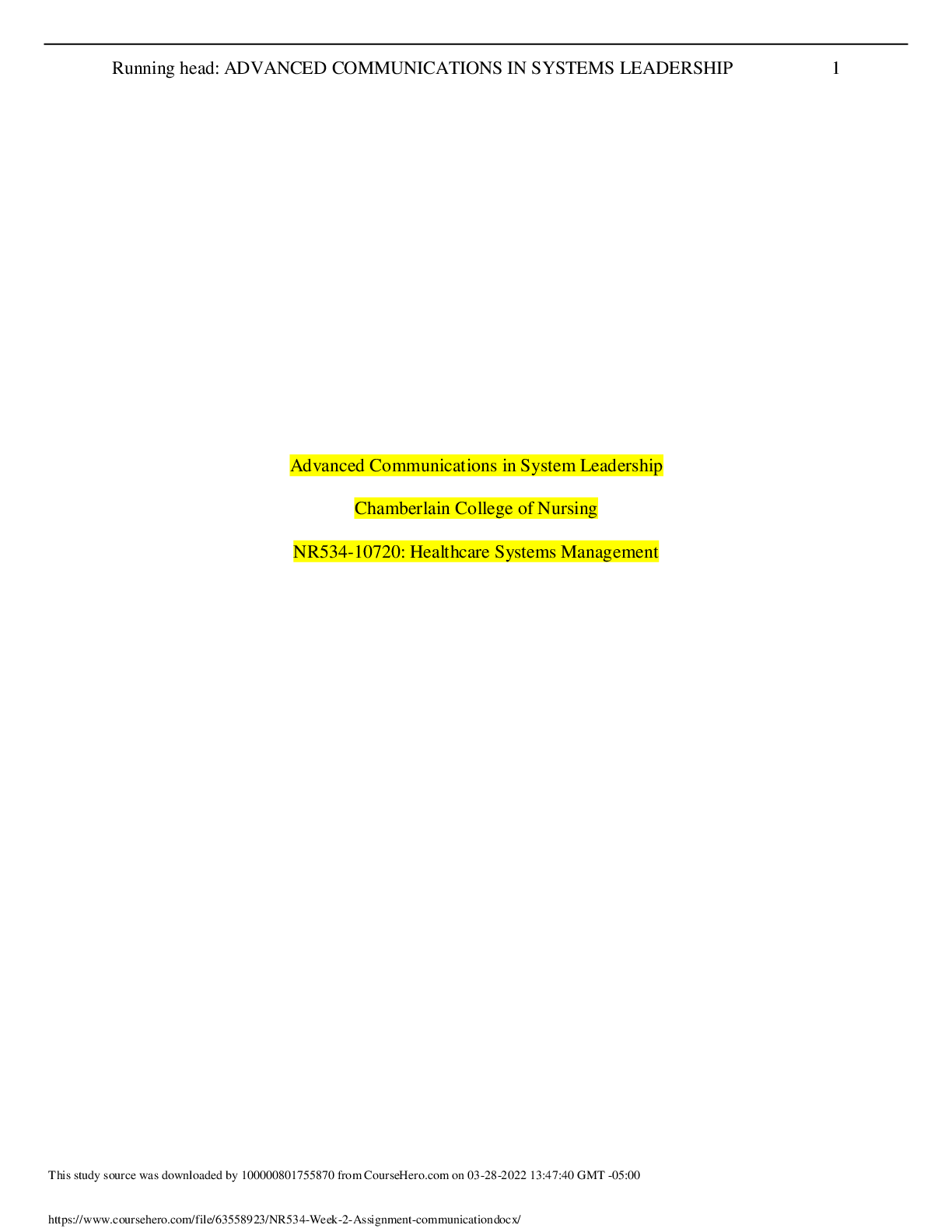
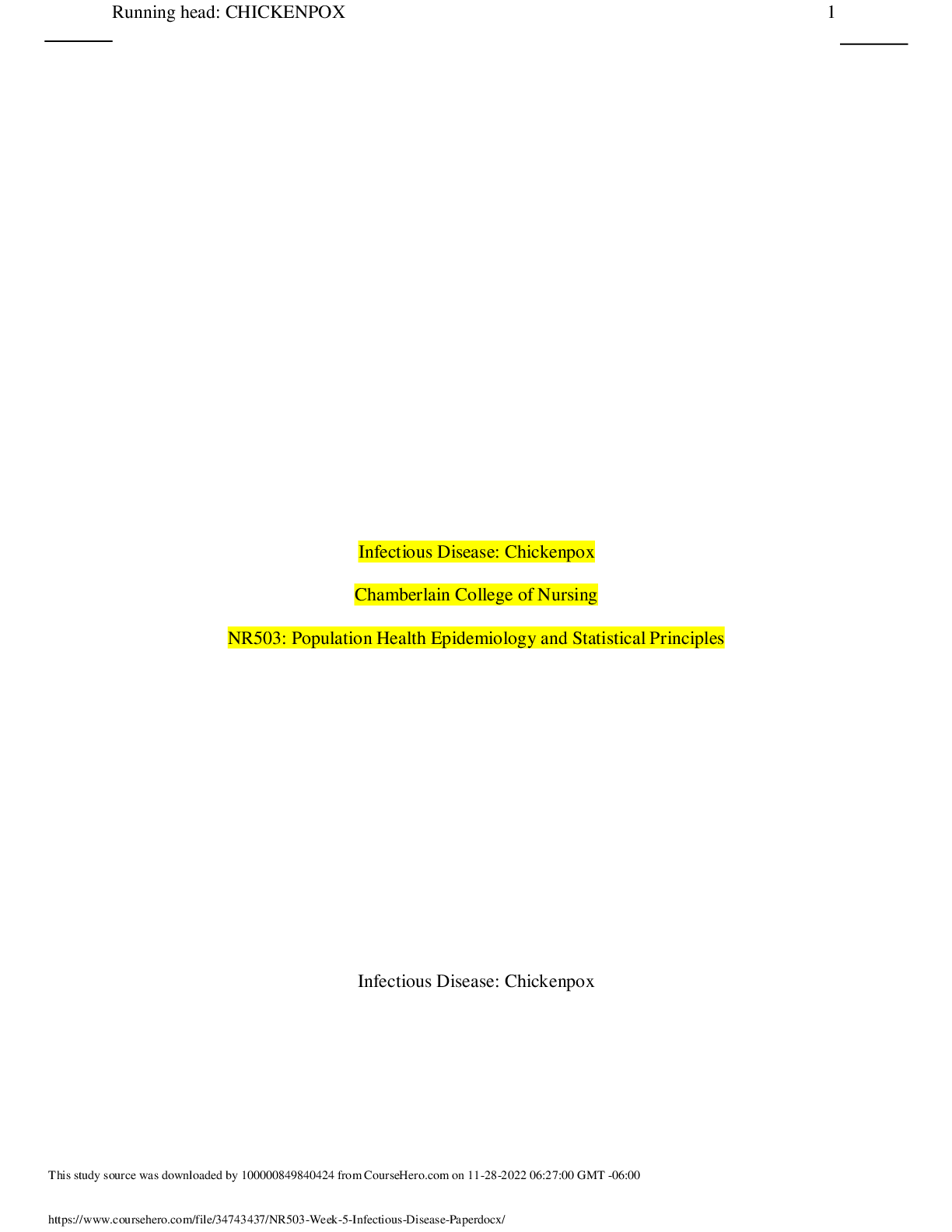


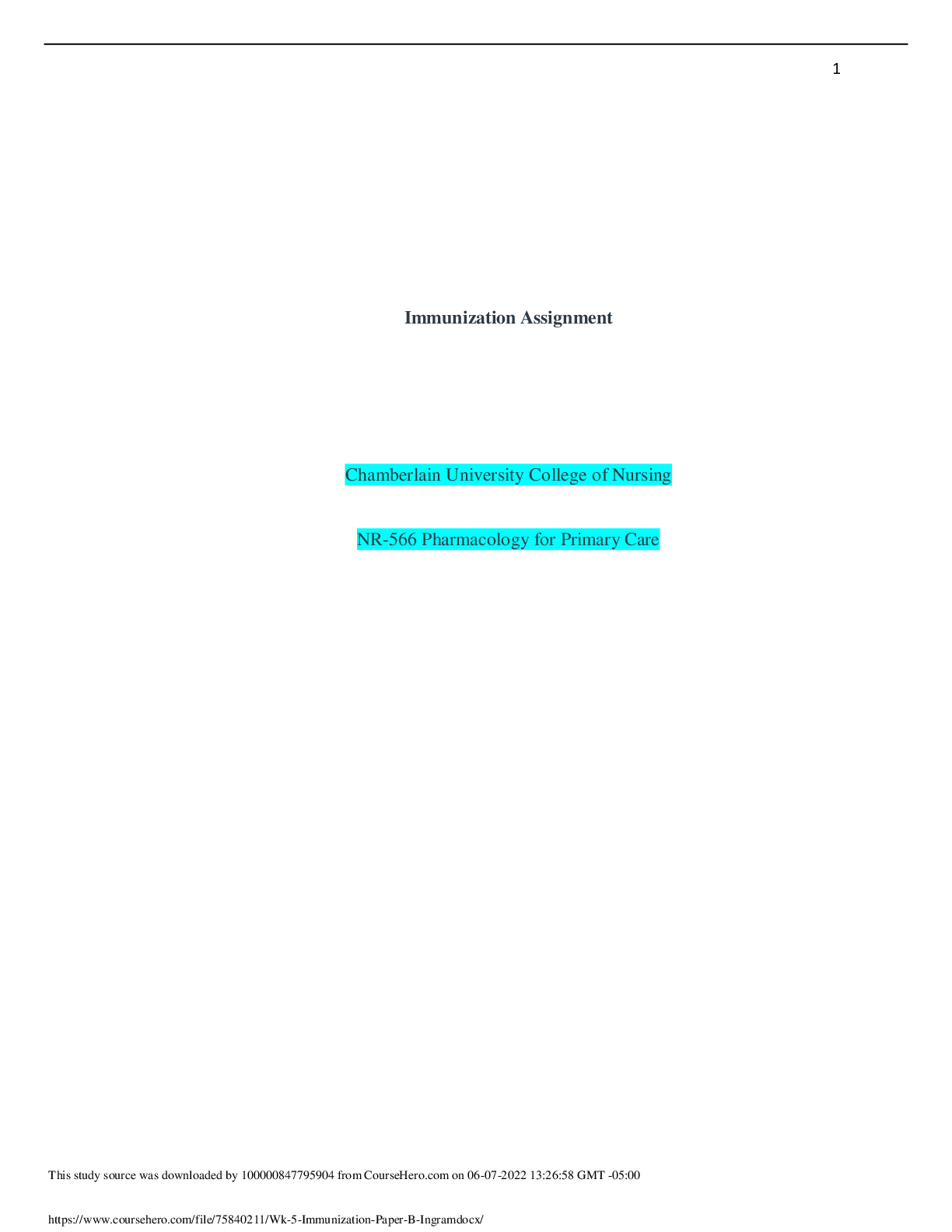

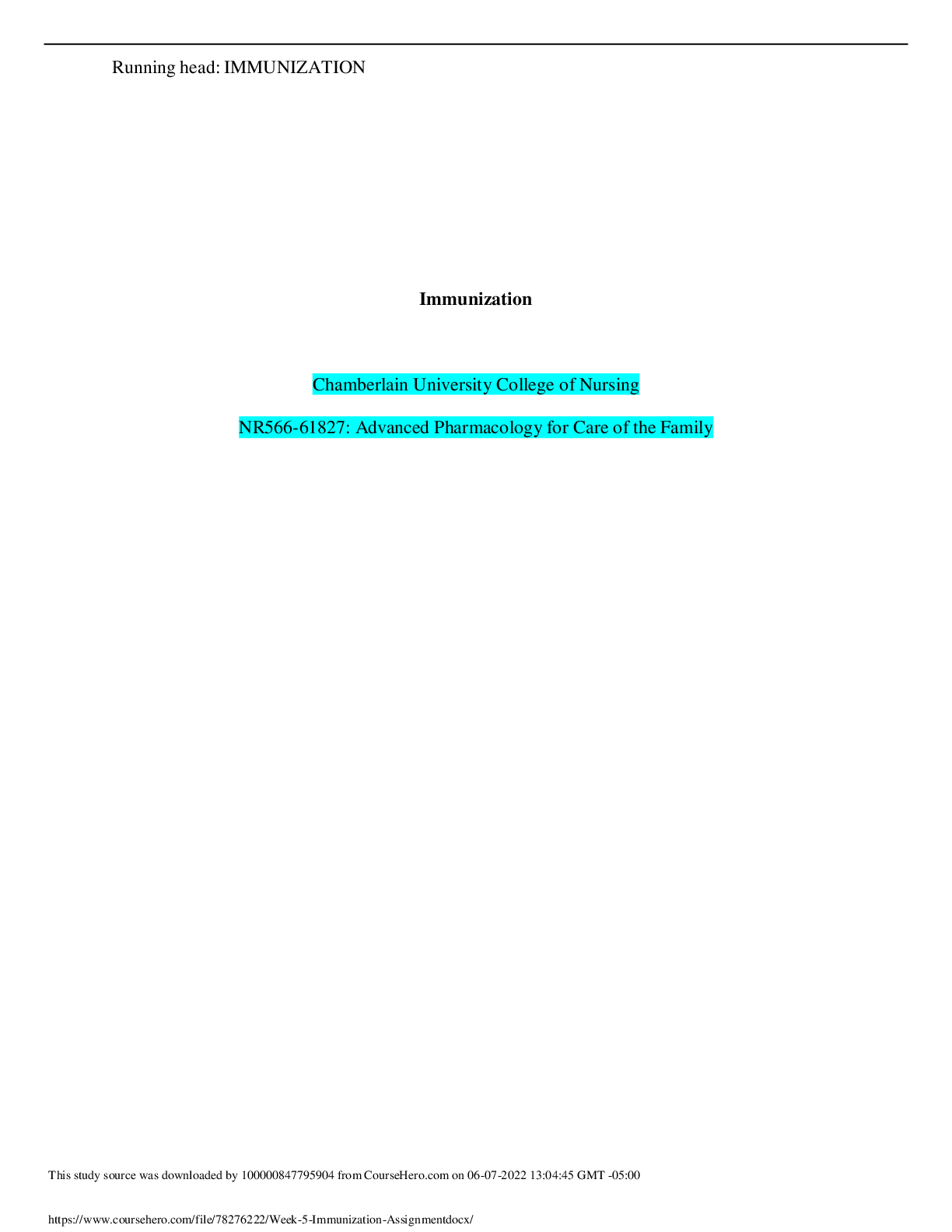
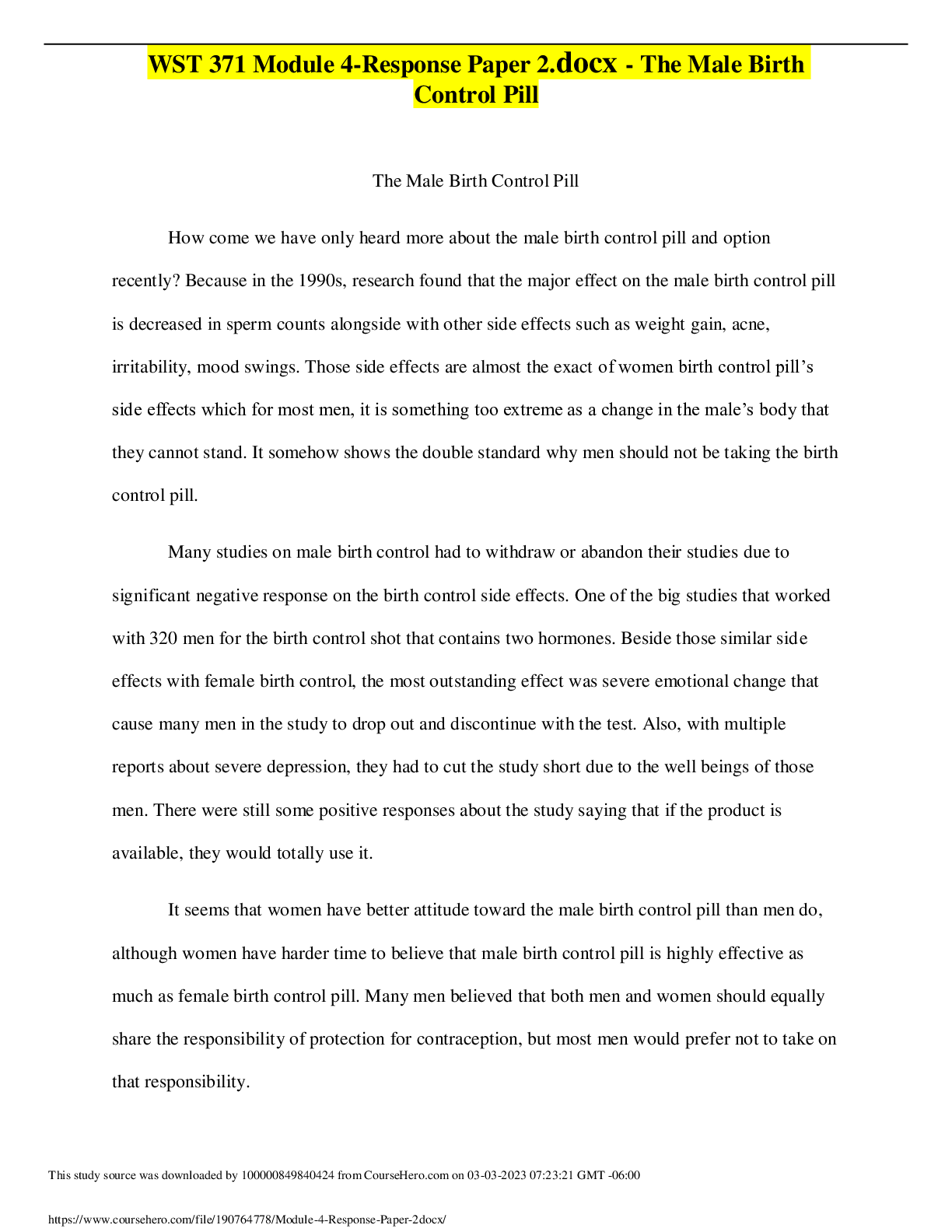
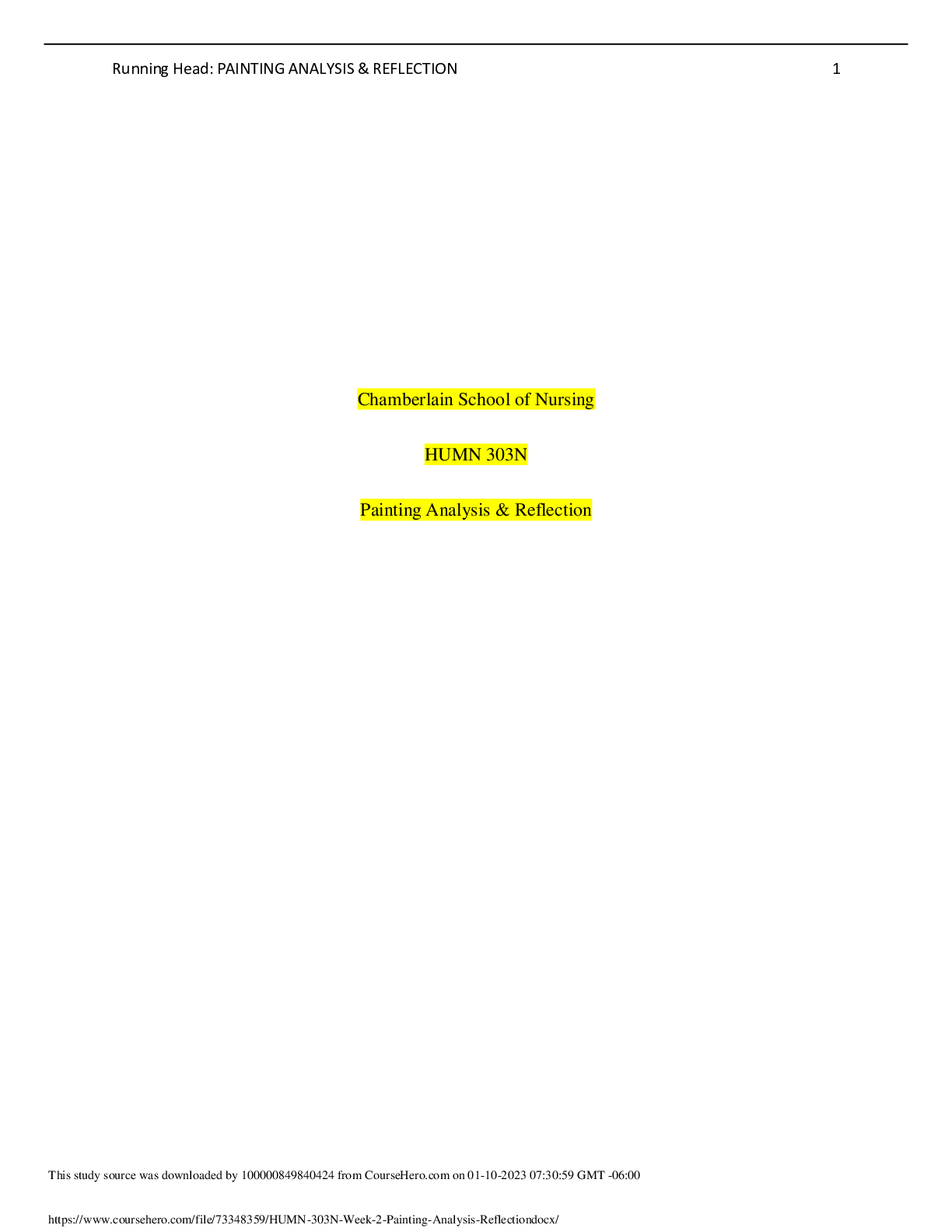


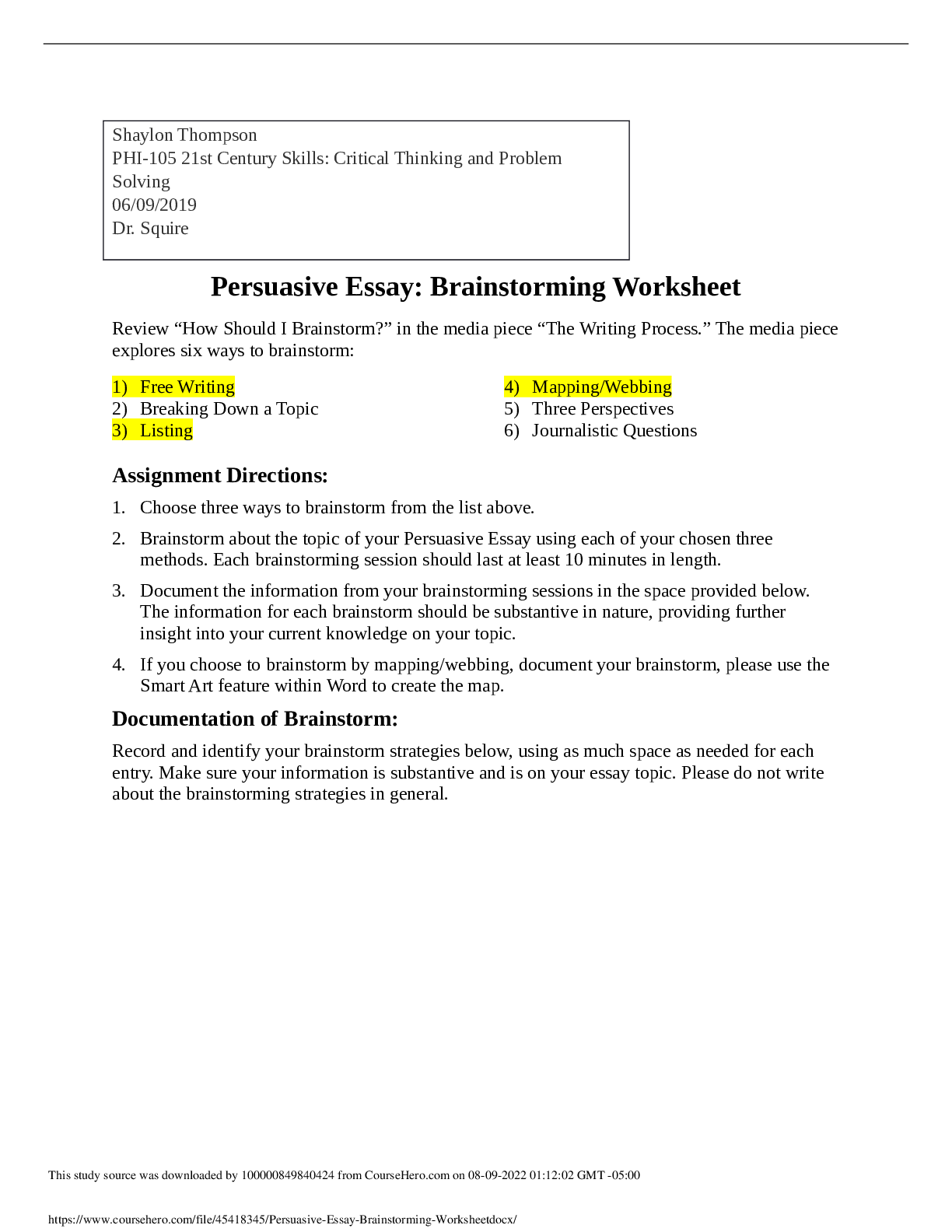

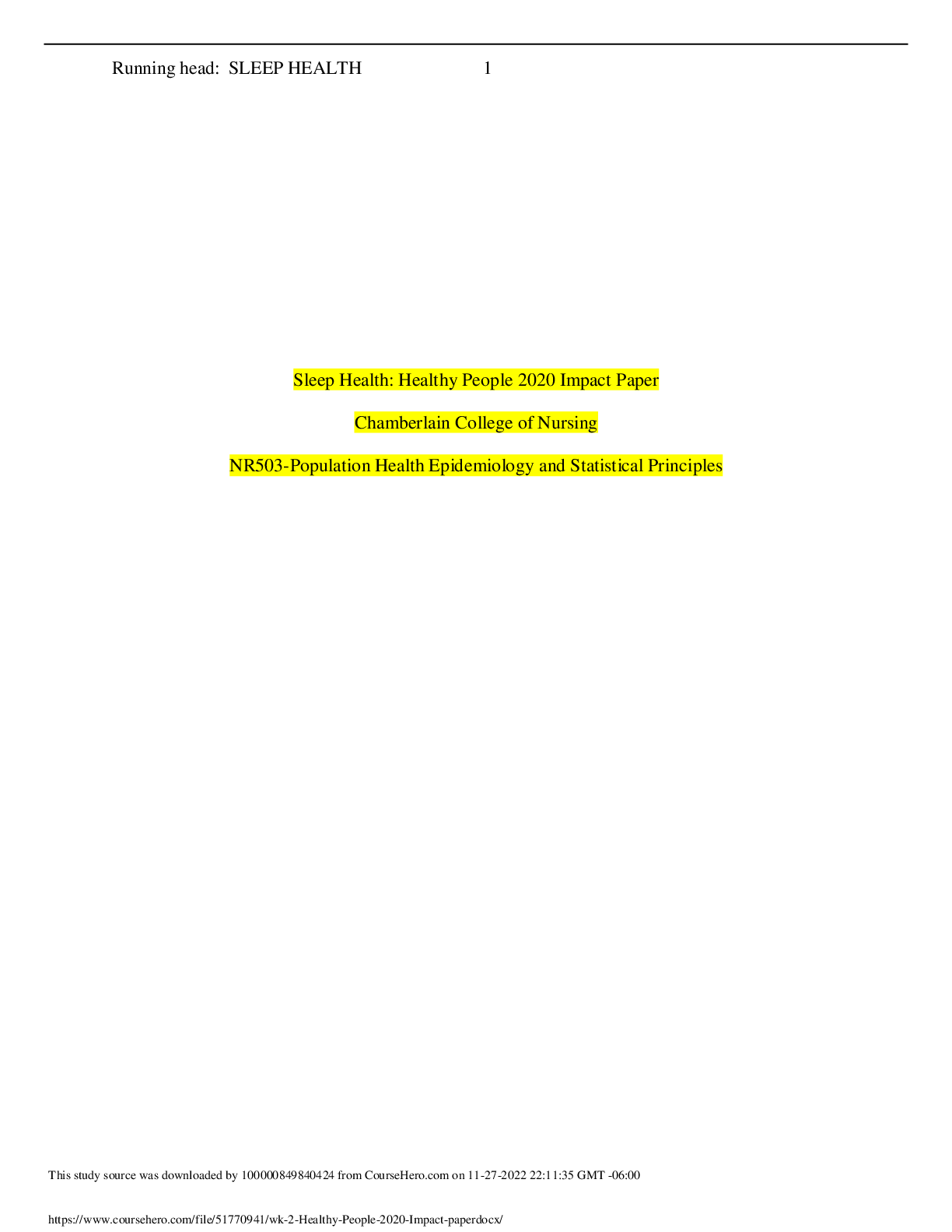
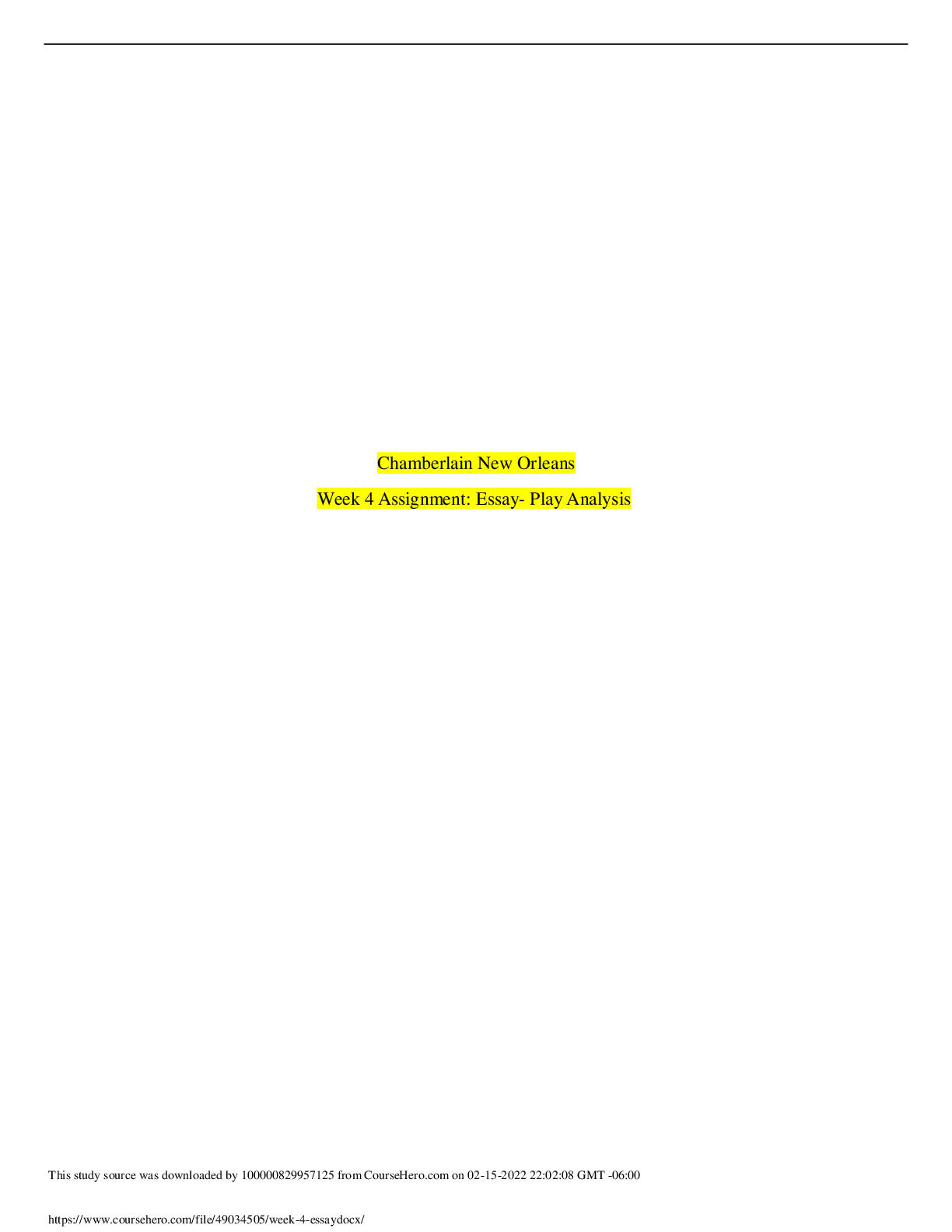
.png)



 (1).png)

